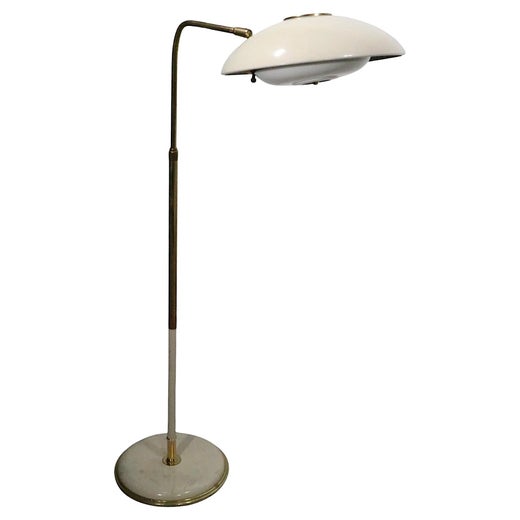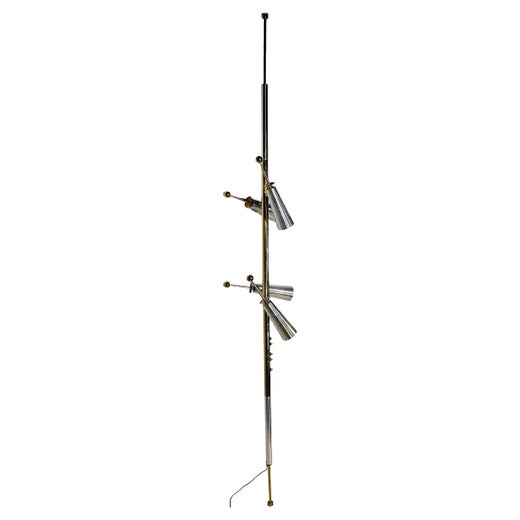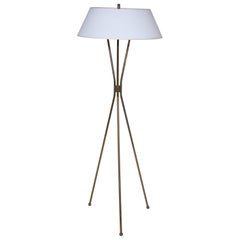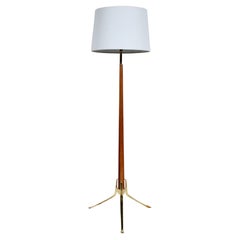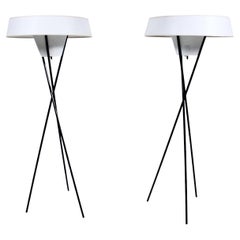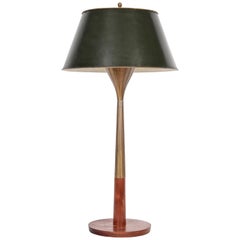Gerald Thurston for Stiffel Marble and Brass Floor Lamp, 1960s
About the Item
- Creator:Gerald Thurston (Designer),Stiffel (Manufacturer)
- Dimensions:Height: 51 in (129.54 cm)Width: 14 in (35.56 cm)Depth: 14 in (35.56 cm)
- Style:Mid-Century Modern (Of the Period)
- Materials and Techniques:
- Place of Origin:
- Period:
- Date of Manufacture:1960s
- Condition:Replacements made: Newly replaced White Linen Shade. Repaired: Minor flecks to base repaired. Rewired: Rewired with Black braided cloth cord.
- Seller Location:Bainbridge, NY
- Reference Number:Seller: 1116100318R713201stDibs: LU913912158553
Gerald Thurston
As the leading designer at Lightolier during the postwar building and design boom, Gerald Thurston created his clever lighting — sleek floor lamps, table lamps and desk lamps — to suit the American lifestyles of 1950s and 1960s. His designs were at the forefront of the mid-century modern lighting revolution — like much of the visionary work being done at the time in furniture and interiors, Thurston’s fixtures are both elegant and totally innovative, reflecting the exploration of new ideas and new technology that consumed designers of the era.
Thurston eventually led a stellar team of international lighting designers at Lightolier. He was important to the pioneering East Coast–based electric lighting company, and rumor has it that because he sketched every design on craft paper, the manufacturer insured his right hand for one million American dollars.
While enrolled in the School of the Art Institute of Chicago during the 1930s, where he earned his degree in industrial design, Thurston worked as a freelance designer for the Zenith Radio Corporation. Once he graduated, he found a position at the New Metal Craft Company. There he designed custom lighting fixtures and decorative objects for architects and interior designers.
Lightolier enticed Thurston to join them in approximately 1950. That same year, New York’s Museum of Modern Art featured a green floor lamp of his in their Good Design Exhibition of 1950. The sculptural lamps that Thurston created for Lightolier are representative of his interest in Scandinavian modernist lighting as well as the revolutionary designs produced by postwar Italian companies such as Arredoluce and Arteluce. (Lightolier partnered with the latter, and Thurston found inspiration in the work of Arteluce founder Gino Sarfatti.)
During Thurston’s decades-long tenure with Lightolier, he became internationally known for his many designs. His modernist fixtures are characterized by clean lines, vibrant colors and an appealing meld of metals and rich woods. His slender-legged Lightolier Tripod floor lamp, introduced in the 1960s, garnered widespread acclaim, while his whimsical Cricket lamp, with its arthropodan shade and slim brass frame, is wholly versatile — it can be hung as a sconce or positioned on a desk and offers direct or diffused light.
On 1stDibs, find vintage Gerald Thurston lighting, decorative objects and more.
Stiffel
When Ted Stiffel (1899–1971) founded Stiffel in 1932 in Chicago, he wanted to make functional, thoughtfully designed table lamps, floor lamps and other fixtures that were available at an accessible price. Born in Memphis, Stiffel first pursued a career in music before serving in World War I. After his discharge, he worked with the Western Electric Company in Chicago and then the Nellie J. Kaplan Company, a lighting firm also in the Windy City.
After he started his own lamp business, Stiffel began supplying area department stores and by the 1940s had opened a large factory that was producing lamps for nationwide sale, eventually competing with the likes of the Frederick Cooper Lamp Company, also based in Chicago.
In 1948, designer Edwin J. Cole joined the company and created some of the firm’s most striking table lamps. Today, Cole’s vintage mid-century modern lighting fixtures for Stiffel, frequently with distinctively tall and shapely ceramic bodies and finished with decorative brass chinoiserie details, are highly prized by collectors.
One of Stiffel’s innovations was his patented switch, which simplified turning lights on and off: All someone had to do was grasp a lamp’s pole and gently pull down. He also designed a pole lamp with a vertical tube that held a series of fixtures on the outside. The upright pole lamp was so innovative that Sears, Roebuck and Company copied it. Stiffel sued, and the case ended up in the Supreme Court in 1964. The ruling against Stiffel was influential in whether states can give a patent to objects that do not have the invention required of federal patents.
After declaring bankruptcy in 2000, the brand was revived in 2013 in Linden, New Jersey, where newly produced high-quality lamps carry the Stiffel name.
Find a collection of vintage Stiffel lamps and other lighting for sale on 1stDibs.
You May Also Like
Mid-20th Century American Mid-Century Modern Floor Lamps
Brass, Steel
Mid-20th Century Mid-Century Modern Floor Lamps
Metal, Brass, Steel
Vintage 1950s American Mid-Century Modern Floor Lamps
Brass, Copper
Mid-20th Century American Mid-Century Modern Floor Lamps
Brass, Steel
Vintage 1960s American Mid-Century Modern Floor Lamps
Metal, Brass
Mid-20th Century American Mid-Century Modern Floor Lamps
Brass
Mid-20th Century American Mid-Century Modern Floor Lamps
Brass
Vintage 1950s American Mid-Century Modern Floor Lamps
Brass, Steel
Vintage 1960s American Mid-Century Modern Floor Lamps
Metal
Vintage 1970s American Mid-Century Modern Floor Lamps
Brass
More From This Seller
View AllVintage 1940s American Mid-Century Modern Floor Lamps
Brass, Metal
Vintage 1960s American Mid-Century Modern Floor Lamps
Metal, Brass
Vintage 1950s American Mid-Century Modern Floor Lamps
Metal
Mid-20th Century American Mid-Century Modern Table Lamps
Brass, Metal
Vintage 1960s American Mid-Century Modern Floor Lamps
Brass
Vintage 1950s American Mid-Century Modern Table Lamps
Marble, Brass
